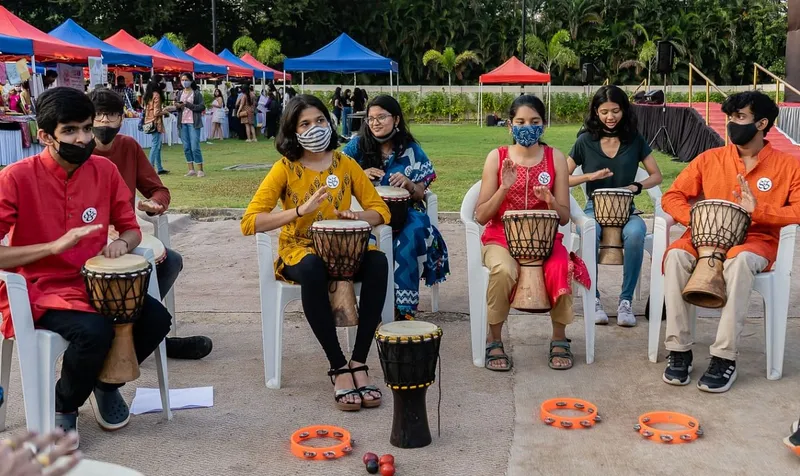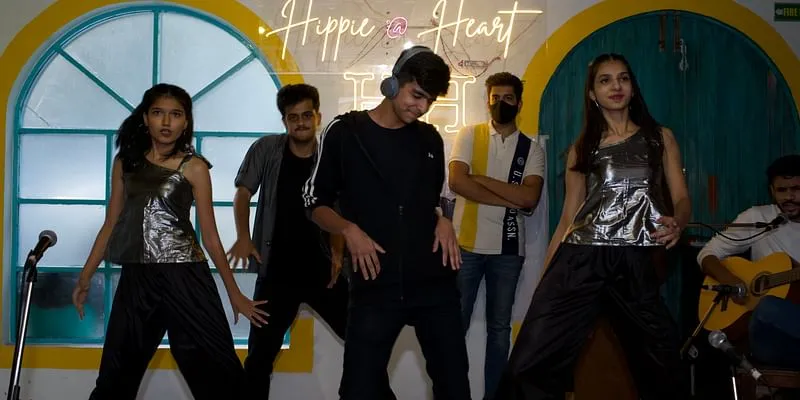This 18-year-old social entrepreneur is helping artists, creators to monetise their art
Suhani Dhadphale started Sangam India in 2020 to empower local artists, entrepreneurs, and creative minds, wherein they can showcase their skills, expand their businesses, and meet their future collaborators.
Eighteen-year-old Suhani Dhadphale from Pune believes that compartmentalised education and a blinkered approach toward the art and creative industry has led to a dearth of opportunities in the creative field.
Lack of monetisation and reduced scope of innovation further discourages students from exploring the field. This is what propelled Suhani to launch , a platform to empower artists, entrepreneurs, and creative minds.
Started in early 2020, Pune-based Sangam has a team of 32 people aged between 14-24 years, and has a community of over 600 artists from across India. It is known for its events where artists and entrepreneurs get to showcase their skills, expand their businesses, and meet their future collaborators.

Suhani during a Sangam event
How it started?
Suhani was a regular young girl who got caught up in her home during the lockdown. As she was exploring Instagram, she got fascinated to see how it can be a platform to help artists and content creators to reach out and perform.
“Sitting idle at home is not something I can do. I was trying something just to keep myself engaged. I have always been fond of writing poetry and performing arts since I was a kid. I wanted to do something which is a confluence of these two fields. And that’s when I realised there is no platform for people to express their art to create something new and to try out new things,” she says.
Sangam was initially started as a social media page on Instagram where Suhani and her friends were making videos about art through a series where people, especially artists, were telling stories about their experiences.
“Sangam aims at monetising art. That’s where we got our elevator pitch from,” adds Suhani.
Initially, Suhani was doing it on her own. In a couple of months, she got a team of three and then it expanded as more like-minded people joined her mission of empowering artists.

Artists performing from the flea market organised by Sangam
“When we started posting about what we are on Instagram, a lot of people approached us where they wanted to share their art form or their insights. We were just experimenting and trying out things back then. So, we used to readily accept their art or whatever they wanted to put out there,” Suhani says.
Today, Suhani is part of the Ashoka Young Changemakers cohort, which includes youngsters from across the country working on pivotal issues.
Expanding the horizon
By the end of 2020, the team started organising events such as open mic space and music festivals. The digital events were done primarily via Zoom as well as through Google Meet and Instagram Live.
“Over the years, I was clear with my vision about how I want to grow Sangam, how the team wants to do it, and how cumulatively everyone's vision can lead to something, which actually can fill in the market gap--monetisation of art. In India, art is still looked at as a luxury and not as a way of life because the field of art is not monetised. It is an unorganised industry to get to and through Sangam, I wanted to give the industry some sort of organisation to give artists their part of monetary shares to prove that it can be a stable revenue source,” Suhani explains.
Suhani says that through Instagram, she gets collaboration requests from poets, musicians, and singers. “Through Instagram alone, we have 2,800 followers, but our account reach is between 18k to 40k, which keeps varying from time to time.”
Suhani adds that most of these artists are young. Apart from giving a monetary share to the artists, Sangam also provides free training and workshops to the young talents, which help them promote themselves in the future.

Sangam has a community of over 600 artists from across India
Soha Shinde, a design student, is one of the artists who has benefitted from Sangam. She says, “I grew up in a society that built a completely different definition of art for me. Although my parents always supported my decisions, it never occurred to me that there are chances of pursuing a career in any field related to art, which I always aspired of. Being a part of Sangam, I got to experience terms like exposure and possibilities. Sangam showed me my perspective of what power art holds. I can’t wait to give my art and talent another chance and see myself as a designer.”
Similarly, for Narendra Shinde, a percussionist, Sangam opened opportunities and let him learn about art management, curating ideas, and networking, which he realised are important for one's growth.
Sangam raised the initial investment from Suhani’s father and has been reinvesting the profit it makes from one event into another.
Recalling their first online event, Suhani says, “It was in December 2020, when the lockdown was at its peak. We decided to have an online and digital art festival because, by that time, a lot of artists and creators wanted to connect with us. We wanted to provide them with a wholesome experience of what art can do and how it can be monetised. Creative confidence from people who come from that industry was something we wanted to do through the event. It was a four-day festival. And we had various recognised speakers from this industry.”
Today, Sangam India conducts offline events mainly in Pune and Mumbai, and is in the process of expanding to other places in the country.
However, growing the startup was not a cakewalk. Owing to her age, there were many who tried to pull her back saying she needed to focus on her studies and Sangam isn’t needed now. But Suhani says she only became more determined.
In India, there are many platforms which work for a niche audience, catering to a single form of skill or art such as Designera and Kopai-Paar.
“We are trying to fill the market gap by catering to all the art forms. We don’t look at any startups or platforms as a competitor, but we surely look at them as an opportunity to collaborate,” says Suhani.
Currently, along with running Sangam, Suhani is pursuing BSc in Economics at Gokhale Institute of Politics and Economics, Pune.
Edited by Megha Reddy






